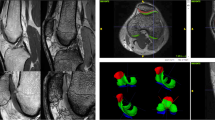Abstract
Purpose
Our study aimed to assess the role of magnetic resonance imaging (MRI) in the characterisation of musculoskeletal tumours and to identify specific perfusion patterns for the different tumours.
Materials and methods
Between January 2003 and September 2005, we evaluated the conventional and perfusion MRIs of 39 patients with musculoskeletal tumours. Dynamic MRI was performed with a 1.5-T and 1.0-T MRI unit before and after the intravenous administration of contrast material, using dedicated phased-array coils appropriate for the region to be studied and fast and ultrafast consecutive sequences. Postprocessing was done on an independent workstation (Advantage Windows, GE Medical System), with Functool (GE) software, which allowed a quantitative evaluation of enhancement as a function of time. The results were compared with the histopathological diagnoses obtained by biopsy or surgery.
Results
The lesions identified in the 39 patients included 23 soft tissue tumours (12 benign, 11 malignant) and 16 bone tumours (ten benign, six malignant). Comparing the time-intensity diagrams of lesions of the same histological type, we found typical enhancement patterns for some bone tumours only, especially for bone, cartilaginous, fibrohistiocytic and pseudoinflammatory lesions. No typical enhancement pattern could be detected for any of the histological types of soft tissue tumour. Analysis of the slope of the time-intensity curves has a sensitivity and specificity of 64%–58% for soft tissue tumours and 86%–67% for bone tumours in determining the biological aggressiveness of the lesions.
Conclusions
Perfusion MRI had moderate sensitivity and specificity in the differential diagnosis between lesions with high or low biological activity. Only in a few cases was it possible to find some correlation between perfusion patterns and lesion histology. The slope values should therefore be used in combination with conventional spin-echo images and other imaging and clinical data in order to narrow the field of the possible differential diagnoses and reliably predict the nature of the lesion.
Riassunto
Scopo
Valutare il ruolo della RM perfusionale nella caratterizzazione delle neoformazioni muscoloscheletriche; in particolare lo studio è volto alla ricerca di pattern perfusionali patognomonici per i diversi istotipi tumorali.
Materiali e metodi
Nel periodo compreso tra gennaio 2003 e settembre 2005 sono stati valutati gli esami RM standard e RM perfusionali di 39 pazienti. Gli esami RM dinamici sono stati eseguiti con apparecchiature RM dotate di un magnete da 1,5 T e da 1,0 T, tramite bobine di superficie dedicate scelte in funzione del distretto da studiare prima e dopo somministrazione ev di MdC utilizzando sequenze rapide ed ultrarapide in successione. La post-elaborazione è stata eseguita in tutti i casi tramite il software Functool installato su una workstation indipendente (Advantage Windows, GE Medical System), che ha permesso, attraverso il posizionamento di una ROI, di effettuare una valutazione quantitativa dell’enhancement in funzione del tempo. I risultati sono stati confrontati con l’esame istologico ottenuto tramite biopsia o intervento chirurgico.
Risultati
Le lesioni dei 39 pazienti esaminati sono risultate essere: 23 tumori dei tessuti molli di cui 12 benigni e 11 maligni e 16 lesioni ossee, di cui 10 benigne e 6 maligne. Confrontando le curve intensitàtempo (TIC) delle lesioni appartenenti ad uno stesso istotipo sono state identificate curve tipiche per alcune lesioni tumorali ossee (serie ossea, cartilaginea, fibroistiocitica) e per le lesioni infiammatorie. Non è stato possibile identificare una curva tipica all’interno dello stesso istotipo per le lesioni dei tessuti molli. È possibile valutare l’aggressività biologica delle lesioni muscolo-scheletriche tramite la pendenza delle curve intensità-tempo con livelli di sensibilità e di specificità che sono rispettivamente del 64%/58% per i tumori dei tessuti molli e del 86%/67% per i tumori ossei.
Conclusioni
La RM perfusionale ha mostrato un discreto livello di sensibilità e specificità nella diagnosi differenziale tra lesioni ad elevata ed a bassa attività biologica e solo in alcuni casi è stato possibile riscontrare una correlazione tra pattern perfusionale e istologia della lesione. I valori di pendenza dovrebbero quindi essere usati insieme con le immagini spin echo convenzionali e con altri dati diagnostici e clinici per restringere le possibili diagnosi differenziali e per poter predire con una significativa attendibilità la natura della lesione.
Similar content being viewed by others
References/Bibliografia
Andrew E Rosemberg (1997) Sistema scheletrico e tumori dei tessuti molli. In: Cotram RS, Kumar V (eds) Robbins. Le basi patologiche delle malattie. Piccin Nuova Libreria, Padova, pp 1361–1424
Shereyaskumar RP, Robert SB (1999) Sarcomi dei tessuti molli e dell’osso. In: Fauci AS, Braunwald E (eds) Harrison. Principi di medicina interna, vol I, 14° edizione. McGraw-Hill Italia, Milano, pp 706–710
Bloem JL, Van der Woude HL, Geirnaerdt MJ et al (2000) Bone tumors. Eur Radiol 10:207–212
Torricelli P, Montanari N, Balzarini L et al (1999) Tumori ossei, Tumori delle parti molli. In: Del Maschio A, Dal Pozzo G, Feltrin GP (eds) Mezzi di contrasto in risonanza magnetica. Poletto Editore, Milano, pp 299–315
Enneking WF (1986) A system of staging musculoskeletal neoplasms. Clin Orthop Relat Res 204:9–24
Verstraete KL, Van der Waude HJ, Hogendoorn PC et al (1996) Dynamic contrast enhanced MRI in the musculoskeletal system. Basic principles and clinical applications. J Magn Reson Imaging 6:311–321
Shapeero LG, Vanel D, Verstraete KL, Bloem JL (2002) Fast magnetic resonance imaging with contrast for soft tissue sarcoma viability. Clin Orthop 397:212–227
Van Rijswijk CS, Hogendoorn PC, Bloem JL (2002) Diffusion-weighted MRI in the characterization of soft-tissue tumors. J Magn Reson Imaging 15:302–307
Van Rijswijk CS, Hogendoorn PC, Bloem JL (2001) Synovial sarcoma: dynamic contrast-enhanced MR imaging features. Skeletal Radiol 30:25–30
Shapeero LG, Vanel D, Verstraete KL, Bloem JL (1999) Dynamic contrast-enhanced MR imaging for soft tissue sarcomas. Semin Muscoloskelet Radiol 3:101–114
Van Rijswijk CS, Hogendoorn PC, Geirnaerdt MJ, Bloem JL (2004) Softtissue tumors: value of static and dynamic gadopentetate dimeglumineenhanced MR imaging in prediction of malignancy. Radiology 233:493–502
Author information
Authors and Affiliations
Corresponding author
Rights and permissions
About this article
Cite this article
Barile, A., Regis, G., Masi, R. et al. Musculoskeletal tumours: preliminary experience with perfusion MRI. Radiol med 112, 550–561 (2007). https://doi.org/10.1007/s11547-007-0161-5
Received:
Accepted:
Published:
Issue Date:
DOI: https://doi.org/10.1007/s11547-007-0161-5




